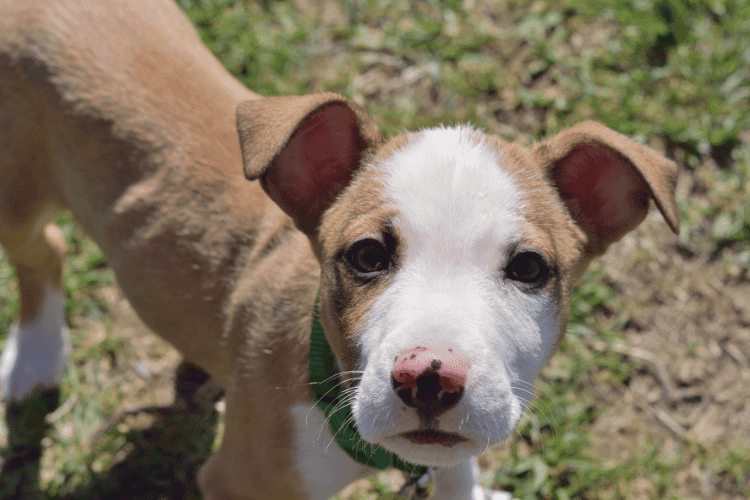Leopard Catahoula dogs can have a wide variety of beautiful coat colors and patterns. One of these colors includes red.
Unfortunately, some patterns, such as the red merle, pose some health risks. Breeders take this into consideration and may choose not to breed merle Leopard Catahoulas because of that.

Patterns of a Red Leopard Catahoula Dog
While we officially refer to the color of this Leopard Catahoula coat as red, it’s more of a deep reddish brown shade.
A red Leopard Catahoula can have a lot of different patterns and not just a solid red color. Below are some of the color patterns and markings of a Leopard Catahoula dog according to the American Kennel Club (AKC)’s breed standards:
- Solid red
- Red merle
- Tan markings
- White trims
Does the Coat Color of a Red Leopard Catahoula Dog Affect Its Health?
This may come as a surprise to a lot, but coat color can have effects on your Leopard Catahoula’s health. This is especially the case with a red merle coat.
When a Catahoula has a red merle color, this means that the chances of the dog carrying the merle genes are high.
Unfortunately, this gene can also affect the color of your puppy's eyes. Catahoulas are among the few select breeds that can exhibit heterochromia—or eyes with different colors from one another—where one of them is usually blue.
The presence of the merle gene can also cause multiple ocular abnormalities as well as congenital deafness.
According to the VCA Animal Hospitals, red Catahoulas—or any dog with red pigments—might not be merle but may give birth to pups that are.
This is important to consider if you have plans to breed your red Leopard Catahoula dog in the future.
Does Coat Color Affect a Red Leopard Catahoula Dog’s Behavior?
You should know that coat color doesn't have an effect on any dog’s behavior. This is why it's not advisable to choose a dog based solely on its appearance.
The red Leopard Catahoula Dog is a beautiful canine aesthetically. But if you want your red Catahoula to have a personality that matches that beauty, you have to work on its training.
Remember that a red Catahoula is still a Catahoula. Regardless if its coat is red or not, its specific breed characteristics will carry over.
When Should You Consider Choosing a Red Leopard Catahoula Dog?
Now, assuming you've considered the specific breed characteristics, too, when should you choose a red Leopard Catahoula? The short answer is if you want to specifically breed Catahoulas with red coats.
Genetically, you have a higher chance of producing red Catahoula puppies if both parents have the same red coat.
However, take note that the Leopard Catahoula puppies may also inherit a variety of different genes for coat color. It can be challenging to perfectly get a red Catahoula every time because it's quite a big gene pool.
Still, not everyone will have plans to breed their red Leopard Catahoulas. If that’s the case, there’s nothing wrong with getting a red Catahoula just because of its eye-catching coat color.
It shouldn't be the only consideration, though. You’ll have to carefully research this breed’s temperament, its physical and mental needs, potential health concerns, and other factors before buying or adopting it.
What Does It Take to Breed a Red Leopard Catahoula Dog?
Breeding for a specific coat color in Catahoulas is challenging even for the most seasoned breeders. What considerations do we have to make and how do we succeed?
Basics of Genetics
All dogs have 39 pairs of chromosomes. These chromosomes carry genes that correspond to different traits we see in dogs, from eye type to coat color.
A Catahoula puppy will have genes that contain a pair of alleles at different sites or loci. This allele pair will come from both the sire and the dam—one allele per parent.
The expression of each allele from one parent at a specific locus only has a 50% chance of appearing in the puppies. However, we also have what we call dominant traits.
The expression of these traits is at a much higher possibility since they’re more dominant than the others. We call less dominant traits recessive traits—they’re usually denoted by small letters, while dominant traits are denoted by capital letters.
Getting the Red Color
There are two pigments that control the coat colors of all dogs: eumelanin and pheomelanin.
We get the Leopard Catahoula's red color through the pigment pheomelanin. Pheomelanin can produce deep reds, yellows, gold, cream, and tan.
The specific shade and intensity that pheomelanin manifests in will depend on eumelanin and other genes. These two main pigments, plus the eight genes associated with coat color in dogs, are responsible for all the possible colors of your pup.
Merle Genetics

Now, we’ve established that Catahoulas can have a merle coat. This makes things a little complicated because a mutation causes this merle pattern.
Even if your red Catahoula doesn’t exhibit a merle coat color, it can still carry this gene. Because all genes will contain an allele from each parent, your sire or dam can pass this gene on to their puppies.
Breeding two merles together significantly increases the health risks we mentioned earlier. Aside from increasing the risks, it also amplifies the intensity of ocular and auditory defects.
The Challenging Part
All of the factors we talked about play a role in determining the coat color of your Catahoula. However, one dog can have a lot of different colors hiding in its gene pool.
Notice that when you look at a litter of puppies, not every single one of them is a mirror image of their parents. Some puppies may express these “hidden” color genes instead of the color you want them to end up with.
This is the challenging part of breeding red Leopard Catahoula dogs. There are a lot of variables that come into play, making this specific dog breed quite genetically complicated.

Calvin is the co-founder and one of the main contributors to dogtemperament.com. He has been an avid dog lover all his life. He enjoys researching and sharing great ideas on how you can avoid common pitfalls of dog ownership and build the most loving and enjoyable relationship with your dog.
Looking for a Dog Breed Price that Meets Your Budget?
Check out our